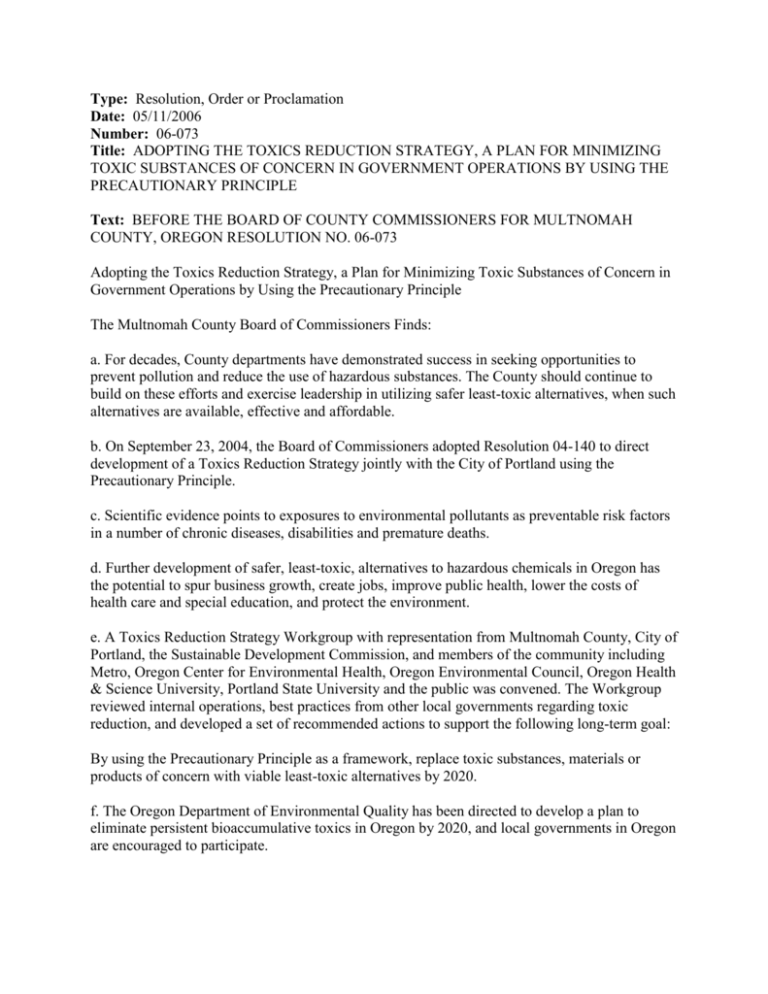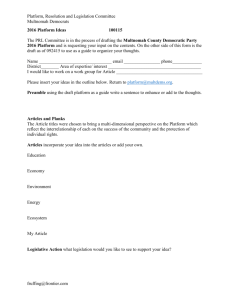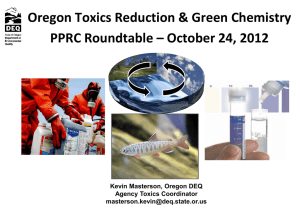OR_Multnomah06-073 - Chemicals Policy & Science Initiative
advertisement

Type: Resolution, Order or Proclamation Date: 05/11/2006 Number: 06-073 Title: ADOPTING THE TOXICS REDUCTION STRATEGY, A PLAN FOR MINIMIZING TOXIC SUBSTANCES OF CONCERN IN GOVERNMENT OPERATIONS BY USING THE PRECAUTIONARY PRINCIPLE Text: BEFORE THE BOARD OF COUNTY COMMISSIONERS FOR MULTNOMAH COUNTY, OREGON RESOLUTION NO. 06-073 Adopting the Toxics Reduction Strategy, a Plan for Minimizing Toxic Substances of Concern in Government Operations by Using the Precautionary Principle The Multnomah County Board of Commissioners Finds: a. For decades, County departments have demonstrated success in seeking opportunities to prevent pollution and reduce the use of hazardous substances. The County should continue to build on these efforts and exercise leadership in utilizing safer least-toxic alternatives, when such alternatives are available, effective and affordable. b. On September 23, 2004, the Board of Commissioners adopted Resolution 04-140 to direct development of a Toxics Reduction Strategy jointly with the City of Portland using the Precautionary Principle. c. Scientific evidence points to exposures to environmental pollutants as preventable risk factors in a number of chronic diseases, disabilities and premature deaths. d. Further development of safer, least-toxic, alternatives to hazardous chemicals in Oregon has the potential to spur business growth, create jobs, improve public health, lower the costs of health care and special education, and protect the environment. e. A Toxics Reduction Strategy Workgroup with representation from Multnomah County, City of Portland, the Sustainable Development Commission, and members of the community including Metro, Oregon Center for Environmental Health, Oregon Environmental Council, Oregon Health & Science University, Portland State University and the public was convened. The Workgroup reviewed internal operations, best practices from other local governments regarding toxic reduction, and developed a set of recommended actions to support the following long-term goal: By using the Precautionary Principle as a framework, replace toxic substances, materials or products of concern with viable least-toxic alternatives by 2020. f. The Oregon Department of Environmental Quality has been directed to develop a plan to eliminate persistent bioaccumulative toxics in Oregon by 2020, and local governments in Oregon are encouraged to participate. g. Exhibit A, “Toxics Reduction Strategy, a plan for minimizing use of toxic substances of concern in government operations by using the Precautionary Principle,” meets the direction outlined in Resolution 04-140 by supporting public health and the environment through precautionary actions that seek least-toxic alternatives. The Multnomah County Board of Commissioners Resolves: 1. To adopt the Toxic Reduction Strategy, a plan for minimizing toxic substances of concern in government operations by using the Precautionary Principle, attached as Exhibit A. 2. To approve formation of a Portland/Multnomah County Toxics Reduction Steering Committee as described in Part 3, Implementation of the Strategy. The Steering Committee will be comprised of key County and City staff who have relevant expertise and responsibilities, as well as external community partners who can add value to these efforts through their knowledge, experience or resources. 3. The Steering Committee, in consultation with affected County departments and City bureaus, should complete the implementation process within three months of the adoption of this resolution. 4. Using the progress reports and updates from staff working on the proposed actions, the Steering Committee will provide an annual update to the Council and Board on the City and County’s overall progress. ADOPTED this 11th day of May, 2006. BOARD OF COUNTY COMMISSIONERS FOR MULTNOMAH COUNTY, OREGON Diane M. Linn, Chair REVIEWED: AGNES SOWLE, COUNTY ATTORNEY FOR MULTNOMAH COUNTY, OREGON By John S. Thomas, Deputy County Attorney









